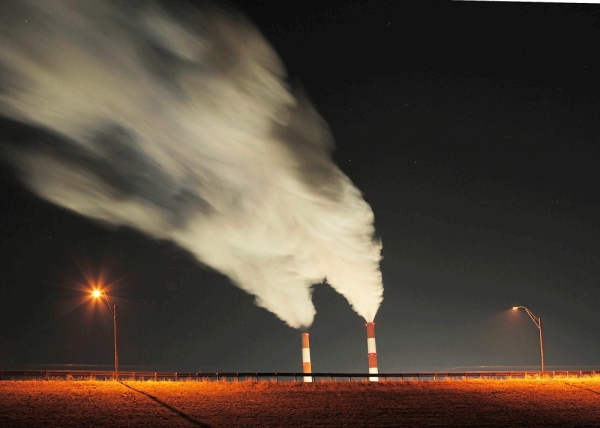
Published by The Star & The Star (Print), image from The Star.
HUMANITY is due for another trophy. We can pat ourselves on the back because we just broke another world record. Recently, the Mauna Loa Observatory in Hawaii recorded a concentration of 415 parts per million (ppm) of carbon dioxide (CO2) in the atmosphere.
Meteorologist Eric Holthaus stated that this is a first for the planet, from even before humans ever existed millions of years ago.
At the current rate of fossil fuel usage, CO2 concentration is expected to exceed 450ppm by 2034.
Now, what do all these numbers mean?
Here’s a brief recap of climate change basics: The concentration of CO2 in the atmosphere correlates to global warming. CO2 and other greenhouse gases such as methane, nitrous oxide and chlorofluorocarbons, trap heat in the atmosphere. More of these gases means more heat is trapped, resulting in higher temperatures.
In climate change studies, a temperature anomaly is the difference from an average, or baseline, temperature. “Global temperature” refers to the global temperature anomaly relative to 1951-1980 average temperatures.
A global temperature of 1°C, for example, indicates the observed temperature is 1°C warmer than the baseline.
According to researchers, the global temperature rising to 2°C will have disastrous consequences: rising sea levels, extreme weather, destruction of flora and fauna, and more.
To avoid further runaway climate destabilisation, researchers advocate for 350ppm as the maximum safe concentration of CO2 in the atmosphere. This would stabilise the global temperature at 1°C
However, that point is long past. But not all hope is lost yet. There’s an old Chinese proverb that says, “The best time to plant a tree was 20 years ago, the second best time is now”. We can still limit the effects of global warming and climate change by acting now.
CO2 makes up a large portion of the greenhouse gases emitted. They come from many different sectors such as electricity generation, transportation, manufacturing, construction and agriculture.
In the energy industry, CO2 is emitted from the combustion of fossil fuels such as oil, coal and gas. However, fossil fuel power plants are slowly being phased out in favour of renewable sources of energy such as solar, hydropower, wind, tidal and geothermal energy.
Tech billionaire Bill Gate’s blog posting on May 14, talked about reducing climate change. He mentioned that the transition towards renewable sources is a great step but they are not yet 100% reliable. Supplying the power grid with clean energy during windless days, in cloudy weather, and at night still poses challenges.
So far, there’s no silver bullet to make us independent of fossil fuels. Renewable energy sources require the support of fossil fuels to meet energy demands. Going forward, the question is how do we reduce CO2 emissions from these fossil fuel power plants? That’s where carbon capture and storage (CCS) comes into play.
As the name suggests, CCS is a method of capturing emitted CO2 from power plants and industrial points and storing it in underground geological formations. It can capture up to 90% of CO2 emissions produced from fossil fuels.
The three ways of capturing carbon are pre-combustion, post-combustion and oxy-combustion.
Once the CO2 has been successfully separated, storing it in gaseous form would take up too much space. So the CO2 is liquefied and pumped deep underground into porous rock formations. Examples of storage sites include depleted oil or gas fields or deep rock reservoirs beneath the sea.
According to the Global CCS Institute CO2RE database in 2018, there are 43 commercial, large-scale CCS facilities worldwide: 18 in operation, five in construction and 20 in various stages of development. Most of these facilities are situated in the United States.
This idea of capturing CO2 and keeping it from being released into the atmosphere was first proposed in 1977. It is only recently that this idea was made a reality and adapted on a large scale to counter the effects of climate change and global warming.
Most countries haven’t adapted this technology due to the high capital cost associated with incorporating CCS into a system, and the lack of an active market in which carbon can be sold. Approximately 80% of the total cost goes into capturing CO2 from the emissions. The cost varies depending on the capturing technique used as well as the type of industry it is used in.
The remaining cost goes into transporting and storing the captured CO2. The gas is most commonly transported into the ground using pipelines. They run from the capture point all the way to a point deep beneath the earth. Pilot projects and research studies have proven that injecting millions of tonnes of CO2 annually into deep saline formations is safe and effective.
With more than 90% of Malaysia’s fuel mix originating from fossil fuels, being able to significantly reduce CO2 emissions from these sources would be a game changer. So how do we get the industry to adopt this technology?
The people must be made aware of future challenges and the negative impact of rapid climate change on the planet. This will help increase public acceptability of CCS projects, as well as attract private investments for them.
Improvements in regulatory structures protecting investors would also help in drawing more investors in. Financial aid and loans from organisations or the government for CCS projects would encourage more adoption of the technology. Funds can be raised for the projects by levying fossil fuel power plants and plants without CCS, and imposing carbon taxes.
As a country striving to become an Asian Tiger, Malaysia’s rapid industrialisation must be met with appropriate pollution control. We are at the stage where CCS needs to be adopted and rapidly deployed to limit CO2 emissions as soon as possible. Climate change doesn’t wait for humanity. This planet’s dying is on us, and only on us. In the end, we will be on the losing side of the battle if we don’t act now.
Eyman Hadi is Research Analyst at EMIR Research, an independent think-tank focused on strategic policy recommendations based upon rigorous research.

